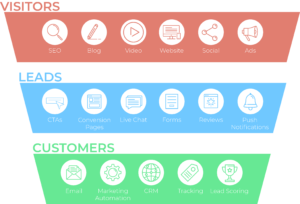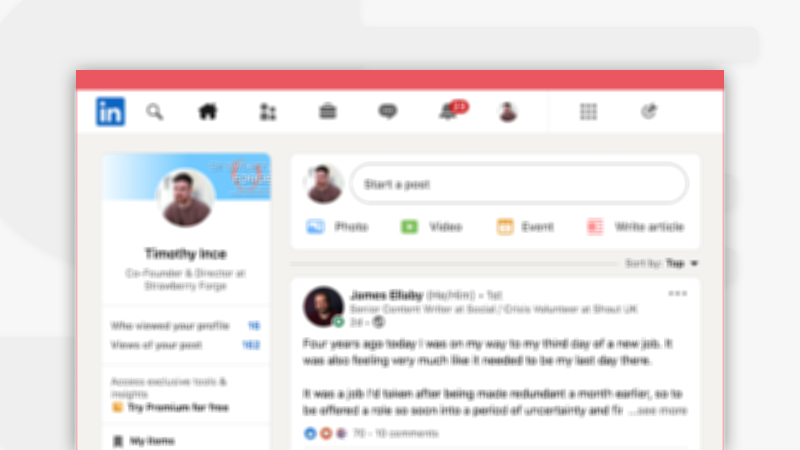It’s fair to say that the internet has transformed every industry on the planet in one way or another. The relatively sudden explosion of free information at our fingertips means buyers expect to be able to research a business and their product easily before deciding whether to purchase.
This is especially important in built environment industries, where consumers are buying at a high price point and therefore want to guarantee they’re getting a good deal before they even speak to the seller.
All this is a long way of saying that you can no longer expect to win sales by simply getting your brand in front of consumers’ eyes. Traditional, printed advertising strategies may build brand recognition, but they won’t increase your revenue.
No, you can’t beat the internet, so you may as well join it. That means more than just throwing up a company website with an about us page and a contact form, you need a full digital marketing strategy.
Your customers exist online, and you can no longer expect them to come to you. It’s time you went to them.
In this blog, we’ll show you how.
The Rusted Tools of Built Environment Marketing

A tradesman is only as good as his tools. If they become rusted and bent, he’s unlikely to produce a high-quality product, which means he’s going to struggle to generate revenue.
In this scenario, the solution is simple – if a tool is no longer fit for purpose it needs to be replaced with something better. Right?
As obvious as this may seem, it is a rule that is often overlooked by companies in built environment sectors when it comes to their marketing. Strategies that worked ten years ago are still being used in full force today, despite their return on investment shrinking significantly.
As such, there is still a reliance within the industry on outdated methods of marketing such as print advertising and exhibitions.
That is not to say there is not still a role for these types of marketing techniques, but the focus should well and truly be on generating leads and customers through digital marketing.
In reality, then, businesses have very little choice – they need to invest in online methods of generating customers. The only question is, do they invest in themselves or someone else?
The Wrong Way to Generate Leads Online
There’s no point in pretending otherwise: digital marketing takes time and energy to get right, especially if you’re starting from the beginning.
You need to consider website design, content marketing, email automation, social media, paid advertising, and all the subtleties that go with them. This isn’t easy if your business is light on digital marketing expertise, so it’s no wonder that most built environment companies turn to others for their lead generation.
A good example of this can be seen in the related industry of property investment, where developers will pay a commission of up to 8% for leads sent their way by websites that host their investment opportunities.
For the property developer, this is great in the short-term, as they have buyers for their developments, but terrible in the long-term, as they are locked into paying a premium price if they want to keep benefiting from leads.
Property developers end up paying these costly commissions because they don’t feel they have the time of capability to generate leads through their own digital marketing, so they spend a fortune to benefit from someone else’s.
A better solution would be to invest in your own marketing so you can generate customers at a fraction of the cost.
Of course, some businesses are already attempting to do this, predominately through pay-per-click advertising (PPC). This is a great first step, but only if you’re using it as a short-term solution while you build a wider, and ultimately more cost-effective, digital marketing strategy.
Speaking of which…
What to Expect From Your Digital Marketing

If you’re going to implement your own digital strategy, it’s important to be clear on what you’re trying to achieve. Digital marketing is not about you going out and finding customers, it is about customers finding you.
The image below describes the four steps your marketing needs to account for in order to attract people to your website, convert them into a lead, close them into a buyer, and delight them as a customer.

As you can see, there are a number of digital marketing techniques you need to use in each step. There’s a few too many to describe them all in this blog, but you can always book some time with us to go through them in more detail.
The first mistake that most businesses make is only focusing on immediately generating customers. Of course, you want to see revenue from your marketing investment as soon as possible, but it’s important to recognise that many people who visit your website won’t be ready to purchase. In fact, research shows that 47% of buyers consume 3-5 pieces of content before purchasing.
The higher the cost of the purchase, the more research potential buyers are going to conduct. So, by only focusing your marketing on people who are ready to buy today, you miss out on the opportunity to provide value to your customers of tomorrow.
We’ll go onto what tactics to achieve marketing success in the short and long-term, but first…
Priming Your Marketing For Success
Before you spend any money on your marketing, you need to take some preliminary steps to ensure it will be successful. The primary measure you’ll need to take is the development of your buyer personas.
Buyer personas are semi-fictional representations of your target customer markets and the Bible by which you’ll plan your marketing strategy.
If developed properly, they’ll highlight the subtleties of what motivates your customers to purchase, what they consider a successful buying experience, and what sends them running from your business.
At this point, you may be thinking that you already know your customers, but you’d be amazed at the variety of opinions that will exist within your business about who you’re actually targeting. A documented set of buyer personas ensures everyone within your organisation is on the same page.
Before you head to Google to learn more about buyer personas, a word of warning: there is a good way and a bad way to conduct this research.
A cursory search on Google will likely present you with a number of articles called something like, “100 buyer persona questions you need to ask”.
These relate to a style of buyer persona that is based on speaking to the business that requires the persona, conducting database analysis, and sending out impersonal customer surveys.
I don’t want to say this is completely useless, but it’s not much more than that.
This type of buyer persona is based on assumptions and delivers little in-depth information. You’ll be left with a persona that tells you little more than basic demographic information such as age and job title and won’t provide your marketing with much direction.
Fundamentally, this type of buyer persona fails because it excludes the thoughts of the most important people: your customers and the prospective customers you missed out on.
It goes without saying that this is the bad way.
Our method for creating buyer personas is based around speaking to actual customers and near-customers and really delving into the subtleties of why they did or didn’t purchase with you.
With this information, you can then tailor your digital marketing strategy to the exact needs of your target customers.
You can learn more about buyer persona development here.
Increasing Website Traffic Through Valuable Content

It will come as no surprise that the first step to digital marketing success is increasing your visibility online. There are a number of marketing techniques to achieve this, but each of these broadly falls into one of two categories: paid and organic.
Paid is a popular method of increasing website traffic due to its speed of set up and ability to deliver results quickly. This, though, comes at a high price, which is, well… price.
If you rely only on paid advertising, either on Google or through social media, your business becomes locked into the monthly cost of running the adverts.
Turn the adverts off and you say goodbye to your marketing.
Organic traffic is website visits generated through search engine optimisation (SEO) and ranking on Google and other search engines. This type of traffic is most commonly generated by content marketing techniques such as blogging.
While organic will likely take a period of six to twelve months to start generating meaningful results, the long-term benefits are much greater. Rank for the right search term on Google and you can benefit from traffic that would cost hundreds or even thousands of pounds to generate through PPC, all for the price of writing one piece of content.
Unlike paid advertising, organic traffic will not disappear when you turn the money tap off. As such, focusing your strategy on organic traffic will allow you to future proof your marketing much more effectively.
Let’s take a more detailed look at some of the marketing methods you may want to make use of when attracting traffic to your website:
Search Engine Optimisation (SEO)
SEO is the art of ensuring your website is visible on search engines like Google or Bing. This involves effectively managing your website to ensure it is not limited by technical issues like broken links, alongside the strategic targeting of high-value keywords (aka. Google search terms).
By targeting the right keywords, you can ensure your website appears at the top of the Google rankings for that term. This will provide your website with regular high-quality traffic, and help your website increase its domain authority (DA).
DA is a scale of one to 100 that Google uses to measure how much value a website has. A website with a score of 70 is judged by Google to be very trustworthy and useful to the search engine’s users. As such, Google ranks it highly, and provides the website with more traffic. So the higher your domain authority, the higher you rank and the more likely you’ll be to rank for highly competitive keywords.
The more keywords you rank for, the more your DA will rise and the more keywords you’ll be able to rank for. Win-win.
Blogging

We’ve just spoken about a lot about the importance of choosing the right keywords to rank for, but how do you actually rank for them? This is where blogging proves itself to be so important.
For every keyword you want to rank for, you’ll need to create a unique piece of website content. Considering you’ll want to target hundreds or even thousands of keywords, you can’t just create a new website page.
By blogging you can target all these keywords neatly and provide useful information for your website traffic, leads and customers regularly.
Even better, Google appreciates it when you publish new content, so whether you rank for a keyword or not, each blog you write will do its bit to increase website traffic.
Pay-Per-Click Advertising
If you can’t afford to wait for your blogging to generate website traffic, you can skip this step by jumping straight into pay-per-click advertising (PPC). Like organic content marketing, you’ll want to begin with keyword research, only this time, you’re not looking for a keyword to rank for, you’re looking for one to pay for.
Pay-per-click is exactly what it says on the tin. You pay Google everytime someone clicks on your advert, which appears on certain search terms. How much you pay will depend on how competitive the keyword is. You could pay pennies, or more than £10 per click.
If you have the money then, PPC can be your ticket to quick results but be warned: just because someone clicks your ad doesn’t mean they will convert on your website. You still need compelling website content at the other end to convince them to take your desired action.
Social Media
Social media offers you an organic approach and a paid one. If you have a strong brand and business ethos, you can make a big splash on platforms like Facebook, Twitter, Instagram and LinkedIn just by posting regularly and letting your personality shine.
Alternatively, you can create targeted ads to drive website traffic. This is similar to PPC but differs in the way you target traffic. With PPC, you target traffic based on what they are typing into Google, whereas social media advertising allows you to build audiences for your advert based on demographics like age, gender and location.
Converting Your Traffic Into Leads

There’s not much point in generating thousands of website visitors if you don’t have a plan for how you’re going to turn them into leads for your sales team.
Therefore, your digital strategy needs to include a plan for how to take website visitors and motivate them to share key pieces of information with you, such as name, email address and phone number.
Before you do this though, you need to ensure you have a Customer Relationship Management (CRM) system that will allow you to accurately keep track of all your leads. This may seem obvious, but you’d be surprised by the number of businesses who are capturing leads but don’t know where any of their information is kept.
HubSpot has a sophisticated CRM that is completely free.
Once you’re confident your lead data will be kept safe, you can begin using the following tools to convert your website traffic.
Calls-to-Action
Calls-to-action (CTAs) are trackable images or buttons on your website and emails that are used to direct traffic to a certain area of your website.
They are most effectively placed on website homepages, where they can immediately direct traffic to key web pages, such a contact or consultation page.
As well as this, they play an important role in channelling the traffic produced by your blogs to conversion points, namely…
Landing Pages
Landing pages have a single purpose: to motivate website visitors to share their email address. With this in mind, unlike the rest of your website, landing pages rarely include links to other parts of the website.
In fact, landing pages are designed to make leaving them as difficult as possible, with no menu navigation allowing access to the rest of the website.
Of course, it is not holding your traffic hostage that motivates them to share their information, you need to offer something in return. In return for their email then, provide them with a free item of value, such as an infographic or eBook.
Forms
Of course, the main tool for converting people from strangers to leads is the strategic use of forms. You’ll use a form on each of your landing pages and the information you ask for will depend on the value of the offer you’re giving them.
If you’re only providing an infographic, don’t ask for anything more than a name and email. Otherwise, you risk putting people off submitting the form. However, if you’re providing a free consultation, you could ask for their phone number and even their budget.
Nurturing Leads into Customers

As previously mentioned, one of the biggest mistakes businesses in the built environment sector make is focusing their marketing only on leads who are ready to purchase now.
The problem with this is that these leads will be few and far between. Most of your leads will be in the research phase, where they are looking for more information about the service or product you offer.
This means they won’t be ready to be approached by your sales team, but will have the potential to become customers in the future. So, ignoring them is not an option.
Digital marketing allows you to nurture these leads into customers over an extended period of time by providing them with regular, valuable content. By building this relationship with them, you ensure that you’re in pole position when they are ready to buy.
Here are three tactics you can use to improve your close rate from lead to customer.
Email Marketing
Email marketing still has an important role to play in modern marketing. If a lead submits a form on your website, you may be able to follow up with other useful information via email, if you have permission under GDPR.
Of course, how you use email marketing will depend on what stage of the buying process you think your lead is in. If they submitted a form to download a free guide on property investment they are likely still researching and not ready for your sales pitch. If, however, they submit to receive a discount voucher, it’s time to close them into a customer.
Automation
Email marketing is all well and good, but you can’t write a message to each and every lead you generate. This is where automation comes in.
By automating your email sequences, you can nurture an unlimited number of leads to the point where they are ready to speak to your sales team without needing to lift a finger.
This automation is likely to be one of the biggest factors to transform your marketing performance and can even help you improve your processes internally.
Lead Scoring
If your marketing software gives you access to lead scoring and you’re not using it, you should be. If lead scoring isn’t an option on your current system, I’d seriously consider changing your provider.
Lead scoring helps you organise which leads you should be targeting first. By creating a scoring system based on lead engagement, you can automatically categorise who is engaging with your marketing most.
This will help your sales team identify hot leads quickly and stop would-be customers slipping through the net unnoticed.
Maximising Revenue From Existing Customers

It makes sense that reselling to existing customers and using them to sell to others should be a major priority for your digital marketing. After all, you’ve already done all the hard work in turning them into a customer in the first place, why let them drift away now?
All of the techniques outlined above can be used in the pursuit of ensuring customers don’t just purchase once, but do so multiple times.
Existing customers also contain gold dust when it comes to providing information about why they purchased, what they liked and what they didn’t. All this information can be added to your buyer personas and used to streamline your marketing so it is more effective in the future.
Alongside this, you can use the following methods to maintain engagement with your customers and delight them even after purchasing.
Remarketing Emails
Just as you enrolled leads into automated chains of emails, so too can you enrol your buyers. This time around though, your emails should be even more compelling, as they can be tailored more specifically to the needs of the customer based on what they purchased in the past.
Send them information about similar products or services, or use your emails to automate satisfaction surveys so you can evaluate your customer service and improve it in the future.
Merely keeping in contact using email could be enough to ensure they purchase with you again in the future.
Smart Content
Think your website can only host one set of content? Think again. Smart content means the text on your website can literally change depending on which customer is visiting.
Say your homepage usually advertises your range of custom kitchens. If a customer has already purchased a kitchen with you, there’s not much point presenting them with this information again.
With smart content, you could present information about your bathroom deals to everyone who has previously purchased a kitchen with you. You could even welcome them by name.
Generating Social Proof
Word of mouth marketing is still hugely influential when it comes to increasing your customer numbers, so you should always be looking to generate social proof like reviews from your customers.
If you’ve provided them with a high-quality service, your customers will likely be happy to give you a glowing recommendation, but this doesn’t mean they won’t need a little push to do so.
Often, reaching out to them and asking them to provide a review, share a testimonial on social media or refer a friend is all you need to do.
No One Ever Moved Forward By Standing Still

So, how do you implement your own digital marketing strategy? You just implement your own digital marketing strategy.
If your website is not generating leads and customers for you, it’s time to do something about it before you fall behind your competition.
Digital marketing can seem like a lot to get your head around, but you don’t have to do so on your own. Book a free Digital Workshop with our digital strategists today and we’ll help you identify which areas of your marketing you should be focusing on first.
From there, we’ll help you put together a strategy for achieving your short, medium and long-term goals.
They say the hardest step is the first one you take. Get in touch today and it’s all downhill from there.







